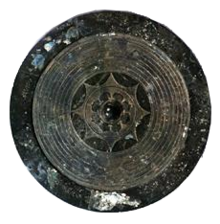User:Immanuelle/Yata no Kagami

Yata no Kagami (八咫鏡) is a sacred bronze mirror that is part of the Imperial Regalia of Japan.[1][2]
Name and significance
The Yata no Kagami represents "wisdom" or "honesty," depending on the source.[2] Its name literally means "The Eight Ata Mirror," a reference to its size.[3][4] Mirrors in ancient Japan represented truth because they merely reflected what was shown, and were objects of mystique and reverence (being uncommon items).
According to Shinsuke Takenaka at the Institute of Moralogy, Yata no Kagami is considered the most precious of the three sacred treasures.[5]
History
In the year 1040 (Chōkyū 1, 9th month), the compartment which contained the Sacred Mirror was burned in a fire.[6] Whether that mirror was irrevocably lost or not, it is said to be housed today in Ise Grand Shrine, in Mie Prefecture, Japan,[7] although a lack of public access makes this difficult to verify. Presently, a replica is enshrined in Three Palace Sanctuaries of the Tokyo Imperial Palace in Tokyo.[2]
Mythology
In Shinto, the mirror was forged by the deity Ishikoridome; both it and the Yasakani no magatama were hung from a tree to lure out Amaterasu from a cave. They were given to Amaterasu's grandson, Ninigi-no-Mikoto, when he went to pacify Japan along with the sword Kusanagi. From there, the treasures passed into the hands of the Imperial House of Japan.[8] The descendants of Ishikoridome, the Kagamitsukuri created ceremonial mirrors for the Emperor when the myths were first written.[9]: 59 .[9]: 35
The double shrine complex Hinokuma Jingu and Kunikakasu Jingu holds two mirrors made before this one. Prototype mirrors Higata no Kagami and Hiboko no Kagami respectively.
The researcher Shinsuke Takenaka said according to the legends, Amaterasu told Ninigi: "Serve this mirror as my soul, just as you would serve me, with clean mind and body."[5][10]
Association with the structure of the Department of divinities
Yata no Kagami, alongside Yasakani no magatama were heavily associated with Imperial ritual. Two of the main clans of the Department of Divinities, the Kagamitsukuri, and the Tamatsukuri were descended from the creators of the respective artifacts: Ishikori-dome no Mikoto, and Tamanooya-no-Mikoto. This was a part of a pattern of the clans of the Department of Divinities being descended from significant figures in the myth of Amaterasu in the cave.[9]: 35 .[9]: 25–26 [9]: 59 Kusanagi is an exception, likely included to represent the submission of the Izumo clan to the Imperial House of Japan.
In the Department of Divinities there was this organization.[9]: 35 .[9]: 25–26
- The Inbe clan was responsible for managing the procuring materials for rituals and performing abstinence rites.[9]: 25–26 and distribution of tribute offerings within the Jingikan..[9]: 35 claiming descent from Ame no Futodama no Mikoto..[9]: 25–26
- Sarume clan women were tasked with performing sacred dances..[9]: 35 Initially serving as seers and healers, their role evolved to include performing ritual dances, or kagura, during Enthronement Rites and court ceremonies..[9]: 25–26 claiming descent from the goddess Ame no Uzume no Mikoto,[9]: 25–26 and Sarutahiko Ōkami. [11][12][13][14]
- The Tamatsukuri specialized in the creation of Magatama..[9]: 35 and are descended from Tamanooya-no-Mikoto. [9]: 59
- The Kagamitsukuri were known for crafting bronze mirrors for use in shrine ceremonies..[9]: 35 and are descended from Ishikori-dome no Mikoto. [9]: 59
- The Urabe clan (卜部氏) considered to be of relatively low rank, carried out divination practices..[9]: 35 [15] using tortoise shells and deer scapulae [9]: 25–26 later taking the surname Yoshida family and claiming descent from Ame no Koyane.[9]: 25–26 alongside the Nakatomi clan.[9]: 25–26
- Nakatomi clan: Later known as the Fujiwara, they specialized in reciting prayers to the Kami, with a divine lineage tracing back to Ame no Koyane no Mikoto..[9]: 25–26
- In his book Jinja to kodai ōken saishi (1989). Iwao Ōwa [ja] goes on to theorize that the Ō clan (多氏, Ō no uji, also written as 大氏) was originally ōmi (大忌, "greater taboo (priesthood)"), but was usurped by the Nakatomi clan who were among the "lesser priesthood" (the latter claims descent from the Inbe clan (忌部氏)).[16]
- Takemikazuchi was originally a local god (kuni-tsu-kami) revered by the Ō clan (多氏, Ō no uji, also written as 大氏),[16] and was a god of maritime travel.[16] However, the Nakatomi clan who also has roots in this region, and when they took over control of priestly duties from the Ō clan, they also instituted Takemikazuchi as the Nakatomi clan's ujigami (clan deity). Or so this is the observation by Iwao Ōwa [ja][16]
All of these clans are descended from figures who played significant roles in the Tenson korin and accompanied Ninigi during his descent, and many of them (Sarume clan, Inbe clan, Nakatomi clan, and Urabe clan) descend from figures (Ame no Uzume, Futodama, Ame no Koyane, and Ame no Koyane respectively) played roles in the myth of Amaterasu in the cave.[9]: 59
The Mononobe clan considered themselves excluded from this, and their ancestor Nigihayahi was excluded. For this reason they wrote the Kujiki. They were highly influential in the development of the department of divinities, but they were not a priestly clan. The Inbe felt their role was minimized so they wrote the Kogo Shui to improve their position too.[9]
Replicas in contemporary ritual


Replicas of the Imperial regalia of Japan including Yata no Kagami are included in Masakaki at Shinto shrines.[18] Masakaki come in sets of two, with the left one containing a replica of Kusanagi no Tsurugi and the right one containing a replica of Yata no Kagami and Yasakani-no-Magatama.[18] Mirrors in Shinto are highly significant with Yata no Kagami being seen as prototypical to them.[17][10]
See also
- Shinju-kyo
- Kashikodokoro Riding Car
References
External links
- Japanese mythology
- Interlanguage link template existing link
- Japanese words and phrases
- Interlanguage link template existing link
- Mirrors
- Tourist attractions in Mie Prefecture
- Buildings and structures in Mie Prefecture
- Ise Grand Shrine
Template:Japan-myth-stub